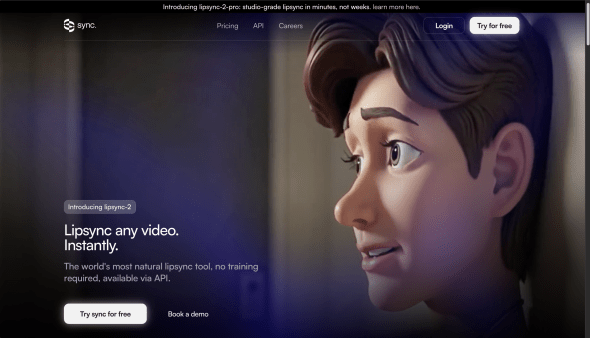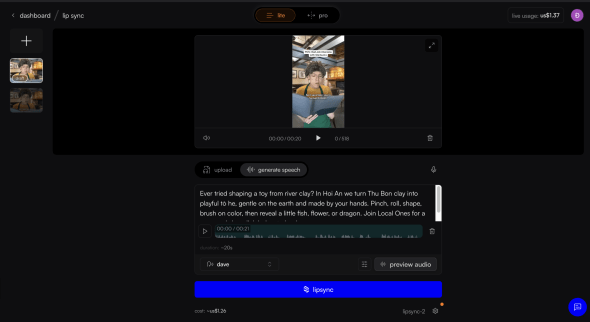Sync.so: Effortless AI Lip-Sync for Any Video
Sync.so is an AI-powered video tool that provides natural-looking lip-sync for any video. Developed by Synchronicity Labs Inc. and launched in 2023, the tool comes from the creators of the well-regarded Wav2Lip model. Sync.so is designed for a broad audience, including video content creators, film and animation studios, and software developers.
Sync.so performs instant synchronization of video footage with any audio track or text, removing the need for extensive training data. This technology alters traditional, labor-intensive workflows for dubbing, translation, and dialogue editing. For industries like entertainment, gaming, and marketing, this means a notable reduction in the time and cost associated with localizing content or making post-production dialogue changes. This platform offers a direct method for a historically complex and expensive problem.
Best Use Case of Sync.so
- Film and Animation Studios: For animators and post-production editors, manually adjusting lip movements to match dialogue is a detailed and time-consuming process. Sync.so automates this entire workflow. An editor can use the tool to apply a new dialogue track to an animated character, making it a functional lipsync ai for animals or other non-human characters in animated features. It works equally well for a live-action actor, generating synchronized lip movements in resolutions up to 4K and saving many hours of manual labor.
- Marketing Professionals: Consider a successful video advertisement that needs to be launched in three new international markets. Instead of reshooting the entire ad, a marketing team can use Sync.so to dub the original video into different languages. The platform adjusts the speaker’s lip movements to match the new audio, maintaining authenticity for each local audience.
- Independent Content Creators: A YouTuber or online course creator often needs to correct mistakes or update information in their videos without reshooting. With this AI agent, they can record a new audio snippet and apply it to the existing video. The tool replaces the original dialogue and adjusts the speaker’s lips, creating a polished final product without the difficulty of a full re-record.
- Game Developers: Creating believable dialogue for non-player characters (NPCs) is a frequent challenge in game development. The tool’s API can be built into a development pipeline to automatically generate lip-sync for thousands of lines of dialogue across multiple languages. This improves player immersion and allows developers to assign resources to other areas of the game.
Zero-Shot Technology: Its core model, lipsync-2-pro, requires no prior training on a specific face to work, making it fast and versatile.
High-Resolution Output: The tool supports video resolutions up to 4K, producing professional-quality results for high-end productions.
Developer-Friendly API: The available API allows for integration into existing video production and game development workflows.
Cost and Time Reduction: Sync.so substantially reduces the cost and time for traditional dubbing, video localization, and dialogue replacement.
Broad Applicability: The technology works on live-action, animated, and other AI-generated characters, offering wide-ranging utility.
Free Trial Option: Users looking for a lipsync ai for free can test the core functionality with the trial version to evaluate its performance before committing.
New to Market: As a newer tool, it lacks a long-term track record and extensive user reviews on major platforms like G2 or Capterra.
Watermarked Free Version: The output from the free version is watermarked, which is not suitable for most professional uses.
Specialized Functionality: The tool is highly focused on lip-syncing and does not offer a broader suite of video editing features.
Potential for Unnatural Look: While advanced, AI-generated lip movements can sometimes appear slightly unnatural or fail to capture the full emotional nuance of a performance.
-
lipsync-2-pro Model: The advanced, zero-shot AI model that performs the tool’s core lip-syncing functions.
-
lipsync studio: An online editor that allows users to upload videos, add new audio or text, and generate the final synchronized video.
-
API Access: An API for developers to integrate Sync.so’s technology directly into their own applications and automated workflows.
-
Multi-Language Video Translation: Enables users to dub videos into any language while maintaining lip synchronization with the new audio track.
-
Automated Dialogue Replacement (ADR): Allows for replacement of spoken lines in a video after it has been filmed, a common task in post-production.
-
Style Replication: The AI can learn and replicate a speaker’s unique talking style for more believable results.
-
Cross-Platform Operation: As a web-based tool, it is accessible from any operating system with a modern browser.
-
Support for Various Character Types: The technology is effective on real humans, animated figures, and AI-generated avatars.
 Homepage Sync.so
Homepage Sync.so
 Lipsync Video From Sync.so
Lipsync Video From Sync.so
Frequently Asked Questions
- What does Sync.so do?
Sync.so is an AI tool that automatically synchronizes the lip movements in a video to match a new audio track or text script. - Who created Sync.so?
Sync.so was created by Synchronicity Labs Inc., a company founded by the original developers of the Wav2Lip AI model. -
How to use a lip-sync AI?
To use a lip-sync AI, a user uploads a video and a new audio file to a platform like Sync.so. The AI processes the files, replacing the original lip movements in the video to match the new audio. The user then downloads the completed video with the synchronized dialogue. - Is there a free version of Sync.so?
Sync.so offers a trial that functions as a lipsync ai for free, allowing users to test the technology. The resulting videos are watermarked. - What types of videos work with Sync.so?
The tool works with live-action videos, 2D and 3D animated characters (including animals), and other AI-generated avatars. - Does Sync.so support different languages?
Yes, Sync.so can be used to dub a video into any language by providing the corresponding audio track. - Is there an API available for Sync.so?
Yes, the company provides an API for developers to build the lip-sync technology into their own software and production pipelines.
Tech Pilot’s Verdict on Sync.so
I have been observing AI video tools, and while avatar generation is common, technology for modifying existing video has been a more difficult problem. For this reason, I wanted to examine Sync.so. Its purpose is not about creating a digital person, but about perfecting the video you have already recorded. My goal was to determine if this tool is a significant asset for post-production or just an interesting piece of tech.
I approached this by considering a common marketing situation: a product demo video where the presenter misspoke a key technical detail. The old method would be a costly reshoot. The Sync.so method involves recording the correct audio, uploading the video and new audio, and letting the AI fix it. Based on the technology, the process itself appears direct. The lipsync-2-pro model’s “zero-shot” capability is a key benefit. The fact that a user would not need to feed it hours of footage to train it is a major advantage over older methods. It suggests a fix in minutes, not days.
My main question, without seeing a direct comparison, is about nuance. Can the AI replicate the subtle muscle movements that show emotion? If an original line was delivered with excitement, but the corrected audio is flat, will the result look odd? The company states its model can replicate a speaker’s style, which is a significant claim and the true test of its quality. For simple dialogue fixes or direct narration, I expect it works well. For highly emotional or dramatic content, its effectiveness is yet to be fully demonstrated.
The pricing model, with its free, watermarked trial, is a good approach. It lets you see the output for yourself. For independent creators, this is quite useful. For studios, the real benefit will come from the API, which can be connected to an automated video localization workflow to process hundreds of videos without manual work.
Tech Pilot’s Verdict on Sync.so
- Rask AI: Rask AI is a video localization platform that offers AI-powered dubbing and voice cloning in addition to lip-syncing. Its core strength is providing an end-to-end workflow for translating video content into numerous languages. Unlike Sync.so’s focused approach on the lip-sync engine itself, Rask AI bundles this with translation and voice cloning services. Rask AI is the better choice for creators and companies who need a complete localization service and are willing to pay for the convenience of an all-in-one platform. If your only need is the highest quality lip-sync for audio you already have, Sync.so may be the more direct tool.
- RunwayML: Runway is a broad AI-powered creative suite for video and image editing, and lip-syncing is one of its many “Magic Tools.” Users can upload a video and an audio track to have the AI sync the mouth movements. The main differentiator is that Runway is a generalist tool; you subscribe to it for dozens of AI features, from video generation to background removal. Runway is a better value if you are a creative professional who needs a wide array of AI tools. However, for a user or business that only needs a dedicated, high-performance lip-sync function, Sync.so provides a more specialized solution without the complexity of a full editing suite.
- Captions: The Captions app is a mobile-first video editor designed for social media content creators. One of its key features is AI Dubbing, which translates a speaker’s words into another language and syncs their lips to match. Its primary audience is creators on TikTok, Instagram, and YouTube Shorts who need fast, convenient tools on their phone. Compared to Sync.so’s high-resolution capabilities, Captions is optimized for speed and mobile workflows. Captions is the superior choice for social media managers and influencers who need to quickly repurpose short-form content for a global audience directly from their phone.
Final Verdict
Sync.so is not just another AI video tool; it is a specialized utility for a specific problem. While other platforms bundle lip-syncing with broader features, Sync.so concentrates on doing one thing exceptionally well. For post-production houses, video localization teams, and content creators who work with existing footage, this tool could become very important. It is new, and it still has to show it can handle the full spectrum of human emotion, but its core technology is functional, and it addresses a real, expensive problem in video production.

